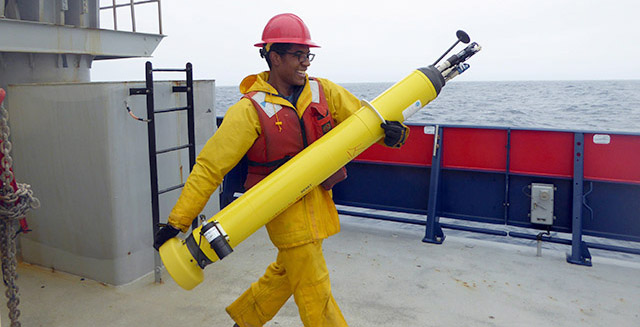Scuba Diving Generates Up to $20 Billion Annually – UC San Diego Today

Report on the Global Economic Impact of Dive Tourism and its Contribution to Sustainable Development Goals
Executive Summary
An international study published in Cell Reports Sustainability provides the first comprehensive analysis of the global economic impact of the scuba diving industry. The research, part of the UN Ocean Decade-endorsed Atlas Aquatica project, reveals that dive tourism is a significant economic driver that provides a powerful incentive for marine conservation, directly supporting several United Nations Sustainable Development Goals (SDGs). The study estimates the industry’s annual contribution to the global economy is between $8.5 and $20.4 billion, creating substantial employment and promoting sustainable practices in coastal communities worldwide.
Contribution to SDG 14: Life Below Water
The report underscores the intrinsic link between dive tourism and the health of marine ecosystems, making it a key economic activity for achieving SDG 14 (Conserve and sustainably use the oceans, seas and marine resources).
- Economic Incentive for Conservation: The economic viability of dive tourism is directly dependent on healthy marine environments. As noted by study co-author Fabio Favoretto, “scuba divers notice if there are no fish — it’s really an activity that is dependent on the health of the system.” This dependency makes dive operators and enthusiasts natural allies for marine conservation.
- Support for Marine Protected Areas (MPAs): Data indicates that approximately 70% of all marine dives occur within MPAs. This preference demonstrates that enhanced marine protection can increase tourism revenue by attracting divers willing to pay for experiences in vibrant, biodiverse ecosystems.
- Non-Extractive Economic Model: Unlike industries such as fishing or mining, dive tourism generates significant income without degrading the marine environment, positioning it as a cornerstone of a sustainable “Blue Economy.”
Contribution to SDG 8: Decent Work and Economic Growth
The study highlights the dive industry’s role in promoting sustained, inclusive, and sustainable economic growth, full and productive employment, and decent work for all, in line with SDG 8.
- Global Economic Impact: The industry’s total economic contribution, including direct and indirect spending, is estimated at $8.5 to $20.4 billion annually. Direct spending on diving activities alone generates between $900 million and $3.2 billion.
- Job Creation: The sector supports up to 124,000 jobs across 170 countries.
- Local Employment: A key finding reveals that 80% of employees in the dive industry are local or national residents, ensuring that economic benefits are retained within coastal communities and contributing to local development and reduced inequalities (SDG 10).
Contribution to SDG 12: Responsible Consumption and Production
Dive tourism, when managed effectively, exemplifies the principles of sustainable tourism outlined in SDG 12, which aims to ensure sustainable consumption and production patterns.
- Sustainable Tourism Model: Lead author Anna Schuhbauer states that well-managed dive tourism can be “economically viable, socially equitable and environmentally sustainable,” contrasting with mass tourism models that can harm local environments.
- Environmental Stewardship: The survey revealed a high level of concern among dive operators regarding environmental degradation, with most reporting negative changes at their dive sites. This awareness fosters a culture of stewardship and a demand for stronger environmental policies.
Contribution to SDG 17: Partnerships for the Goals
The research itself, and the initiatives it describes, are prime examples of the multi-stakeholder partnerships required to achieve the SDGs, as called for in SDG 17.
- Atlas Aquatica Initiative: Led by Scripps Oceanography’s Octavio Aburto-Oropeza, this UN-endorsed project aims to organize the diving sector to create a unified political voice for conservation.
- Formation of Cooperatives: The project is actively supporting the establishment of dive operator cooperatives in locations such as Mexico and Italy to strengthen their role in marine management and policy-making.
- International Collaboration: The study involved a broad coalition of researchers from institutions including UC San Diego, Simon Fraser University, the University of British Columbia, and the National Geographic Society.
Study Methodology
To determine the global economic impact, researchers undertook a comprehensive data collection and analysis process:
- A database of over 11,500 dive operators in 170 countries was compiled using data from Google Maps and the Professional Association of Diving Instructors (PADI).
- An online survey was conducted, receiving 425 responses from businesses across 81 countries.
- Economic analysis, led by Andrés Cisneros-Montemayor, calculated direct spending on diving and indirect spending on related services like accommodation, food, and transport for an estimated 9-14 million annual divers.
- Statistical modeling was used to extrapolate these figures to a global scale.
Recommendations for Sustainable Management
Based on the findings, the researchers propose several actions to leverage dive tourism for greater conservation and sustainable development outcomes:
- Establish standardized monitoring systems across the global diving industry to track environmental health and economic impact.
- Formally include dive operators and their cooperatives in marine management and policy decisions.
- Recognize ecotourism not as a peripheral activity but as a central component of sustainable ocean-based or “blue” economies.
Analysis of SDGs, Targets, and Indicators
1. Which SDGs are addressed or connected to the issues highlighted in the article?
-
SDG 8: Decent Work and Economic Growth
The article directly connects the scuba diving industry to significant economic contributions and job creation. It estimates the industry contributes “$8.5 and $20.4 billion to the global economy each year, supporting up to 124,000 jobs.” It also highlights that “80% of employees are local or national residents,” emphasizing local economic benefits and decent work opportunities within coastal communities.
-
SDG 12: Responsible Consumption and Production
The article positions well-managed dive tourism as a model for sustainable economic activity. It quotes a researcher stating, “dive tourism, when managed well, can be economically viable, socially equitable and environmentally sustainable.” This aligns with the goal of promoting sustainable tourism and decoupling economic growth from environmental degradation. The recommendation to establish “standardized monitoring systems” also supports the goal of tracking the sustainability of tourism practices.
-
SDG 14: Life Below Water
This is a central theme of the article. The entire premise is that the economic viability of the diving industry is dependent on marine health. The article states, “scuba divers notice if there are no fish — it’s really an activity that is dependent on the health of the system.” It provides an economic incentive for conservation by showing that “increased ocean conservation could increase dive revenue.” The fact that “70% of all marine dives currently occur within MPAs (marine protected areas)” further strengthens the link between conservation and the diving economy.
-
SDG 17: Partnerships for the Goals
The article exemplifies and advocates for multi-stakeholder partnerships. The study itself is an “international study” co-authored by researchers from multiple institutions and endorsed by the “United Nations Ocean Decade.” Furthermore, it recommends “formally including dive operators in marine management decisions” and highlights the “Atlas Aquatica” initiative, which supports the formation of “dive operator cooperatives” to create a “unified political voice” for conservation.
2. What specific targets under those SDGs can be identified based on the article’s content?
-
Target 8.9: By 2030, devise and implement policies to promote sustainable tourism that creates jobs and promotes local culture and products.
The article provides the economic data needed to argue for such policies, showing that dive tourism generates billions of dollars and supports up to 124,000 jobs, with a high percentage of local employment. The authors explicitly state their hope that the study “will encourage policies that invest in diving by increasing marine protections.”
-
Target 12.b: Develop and implement tools to monitor sustainable development impacts for sustainable tourism.
The study itself serves as a tool for understanding the economic impact of dive tourism. The article explicitly recommends “establishing standardized monitoring systems across the diving industry” to track environmental and economic effects, directly aligning with this target.
-
Target 14.2: By 2020, sustainably manage and protect marine and coastal ecosystems to avoid significant adverse impacts.
The article argues that the economic health of the diving industry is a direct result of ecosystem health. It notes that dive operators are concerned about “environmental degradation” and that their business model provides a strong incentive to protect marine ecosystems, making them “natural allies in conservation efforts.”
-
Target 14.5: By 2020, conserve at least 10 per cent of coastal and marine areas.
The article supports this target by demonstrating the economic value of conserved areas. The finding that “roughly 70% of all marine dives currently occur within MPAs” provides a powerful economic argument for the creation, expansion, and effective management of marine protected areas.
-
Target 14.7: By 2030, increase the economic benefits to… countries from the sustainable use of marine resources, including through sustainable management of… tourism.
The article quantifies the economic benefits of dive tourism across 170 countries, positioning it as a key component of the “Blue Economy.” It shows how this form of tourism can allow “coastal communities can prosper while protecting their marine resources,” directly contributing to this target.
-
Target 17.17: Encourage and promote effective public, public-private and civil society partnerships.
The article describes the Atlas Aquatica initiative, which is actively “supporting dive operators’ efforts to organize into cooperatives that have a unified political voice.” This effort to organize the private sector (dive operators) to engage in policy and management is a direct example of promoting civil society and private-sector partnerships.
3. Are there any indicators mentioned or implied in the article that can be used to measure progress towards the identified targets?
- Economic contribution of tourism: The article provides a global estimate of the diving industry’s economic impact, ranging from “$900 million and $3.2 billion annually” in direct spending to “$8.5 and $20.4 billion” with indirect spending. This serves as a direct indicator for Target 8.9.
- Number of jobs in the tourism sector: The study estimates that the industry supports “up to 124,000 jobs.” The proportion of these jobs held by local residents (“80% of employees are local or national residents”) is another key indicator of local benefit.
- Coverage of marine protected areas (MPAs): The statistic that “70% of all marine dives currently occur within MPAs” is a powerful indicator of the economic relevance and use of protected areas, relevant to Target 14.5.
- Number of recreational divers: The estimate of “9-14 million annual recreational divers worldwide” is an indicator of the scale of the industry and its potential impact, both economic and environmental.
- Number of private-sector partnerships: The mention of “early pilot dive operator cooperatives in Mexico and Italy” provides a baseline indicator for measuring the growth of such partnerships, as advocated for in Target 17.17.
- Perceived environmental change: The survey finding that “most [dive operators] reporting negative changes at their dive sites over the past decade” is an implied qualitative indicator that can be used to monitor the health of marine ecosystems (Target 14.2).
4. Table of SDGs, Targets, and Indicators
| SDGs | Targets | Indicators Identified in the Article |
|---|---|---|
| SDG 8: Decent Work and Economic Growth | 8.9: Promote sustainable tourism that creates jobs. |
|
| SDG 12: Responsible Consumption and Production | 12.b: Develop and implement tools to monitor sustainable development impacts for sustainable tourism. |
|
| SDG 14: Life Below Water | 14.2: Sustainably manage and protect marine and coastal ecosystems. |
|
| 14.5: Conserve at least 10% of coastal and marine areas. |
|
|
| 14.7: Increase economic benefits from the sustainable use of marine resources. |
|
|
| SDG 17: Partnerships for the Goals | 17.17: Encourage and promote effective public, public-private and civil society partnerships. |
|
Source: today.ucsd.edu

What is Your Reaction?
 Like
0
Like
0
 Dislike
0
Dislike
0
 Love
0
Love
0
 Funny
0
Funny
0
 Angry
0
Angry
0
 Sad
0
Sad
0
 Wow
0
Wow
0











































































